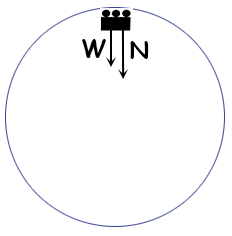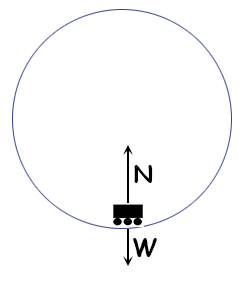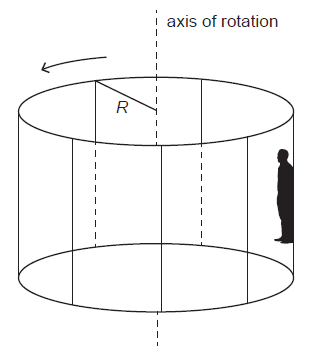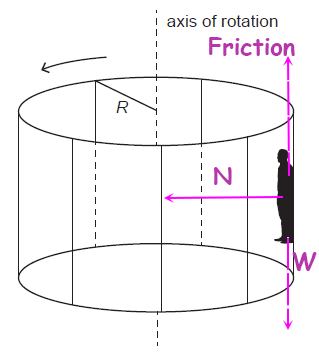Physics > Motion > Uniform circular motion - Problems and exercises
The vertical circle problem:
1) A roller-coaster car enters a circular-loop portion of the ride, in which it travels at the contatnt peed of 30 m/s. If the radius of the loop is 20 m and the total mass of the car (plus passengers) is 1500 kg, what is the the normal force exerted by the track on the car at the top of the loop? Also find the normal force exerted by the track on the car when it is at the bottom of the loop.
Answer:

The centripetal force, as always, is composed by the forces that point to the centre of the circle.
At the top of the loop, the weight and the normal force are pointing downward. So,
Fcp = N + W

At the bottom of he loop, the weight and the normal point at opposite directions. The resulting centripetal force will be:
Fcp = N - W
Now we just have to plug the numbers :
Fcp = m v2 / r = (1500*30*30) / 20 = 67500 N (notice that this calculation can be copied and pasted into google to be performed, as it is)
W = mg = 1500*10 = 15000 N
So,
at the top of the trajectory we have:
Fcp = N + W => N = Fcp - W = 67500-15000 = 52500 N
at the bottom of the trajectory:
Fcp = N - W => N = Fcp + W = 82500 N
2) A string 3 m long is used to whirl a 2 kg object in a vertical circle at a speed of 10 m/s. What is the tension (T) in the string
a) at the top of the trajectory?
b)at the bottom of the trajectory?
Answer:
Using the same resoning presented in the previous question, but substituting the normal by the tension, we have:
a) Fcp = T + W
Fcp = m v2 / r = (2*10*10)/ 3 = 66.7 N
T = 66.7 - mg = 66.7 - 20 = 46.7 N
b) Fcp = N - W
N = 66.7 + 20 = 86.7 N
2.1) get slack string question from IB
3)IB question:
The Rotor is an amusement park ride that can be modelled as a vertical cylinder of inner radius rotating about its axis. When the cylinder rotates sufficiently fast, the floor drops out and the passengers stay motionless against the inner surface of the cylinder. The diagram shows a person taking the Rotor ride. The floor of the Rotor has been lowered away from the person.

a) Draw and label the free-body diagram for the person.
b) The person must not slide down the wall. Show that the minimum angular velocity of the cylinder for this situation is

where is the coefficient of static friction between the person and the cylinder
c) The coefficient of static friction between the person and the cylinder is 0.4
. The radius of the cylinder is 3.5 m . The cylinder makes 28 revolutions per
minute. Deduce whether the person will slide down the inner surface of the
cylinder.
Answers:
a)

The force represented by N is the normal and it is the only force pointing to the centre of the rotor, so that it is the centripetal force. Friction compensates for the weight, so that the person doesn´t fall down.
b) The normal is the centripetal force and it is related to the weight because it is acting against gravity. That means that we can write two equations to find out the necessary angular velocity:
(I) N = Fcp = m v2 / r = m ω 2 r
(II) mg = uN => N = mg /μ
Putting 1 and 2 together:
m ω 2 R = mg/ μ
ω 2 = g/μR
ω = √g /μR
c) Here you just need to plug the numbers on the formula, to find that the minimum angular velocity for the given data is 2.6 rad/s and that calculated using the numbers in this item is 2.9 rad/s, so that the person doesn´t slide.
4)IB question:
Mass M is attached to one end of a string. The string is passed through a
hollow tube and mass m is attached to the other end. Friction between
the tube and string is negligible.

Mass m travels at constant speed v in a horizontal circle of radius r. What is mass M?
Answer:
It looks complicated but it is not. The drawing is only showing that the centripetal force is the weight of M. So:
Fcp = m v2 / r = Mg
M = m v2 / gr
5) IB question:
An object of mass m makes n revolutions per second around a circle of radius r at a constant speed. What is the kinetic energy of the object?
ω = 2π n
v = 2π n r
KE = m v2 / 2 = m 4 π2n2 r2 / 2 = 2m π2n2 r2
other page
6) IB conical pendulum
